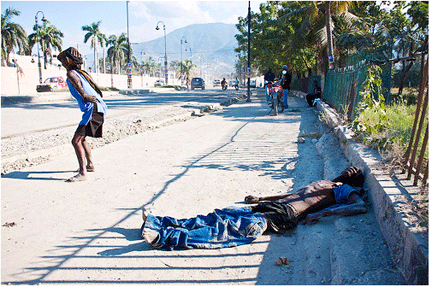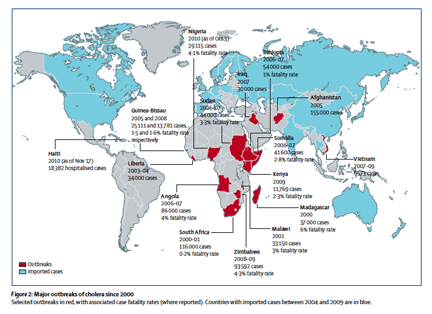Seeding Reconstruction or Destruction?
 Wednesday, March 30, 2011 at 08:51PM
Wednesday, March 30, 2011 at 08:51PM An investigation into the distribution of Monsanto and other seeds post-January 12
Port-au-Prince, March 30, 2011 – Last year, tens of thousands of tons of tools, seeds and plant cuttings were distributed to almost 400,000 Haitian farming families, perhaps one-third to one-half of the country’s farming population.
The $20 million program – spear-headed by the UN Food and Agriculture Organization (FAO), and carried out by the FAO and large international “non-governmental organizations” or “INGOs” like Oxfam, USAID, Catholic Relief Services, as well as the Ministry of Agriculture – was kicked into action in the weeks following the January 12, 2010, earthquake.
Warning of a looming “food crisis,” the FAO and large INGOs urged funders to help them buy seed and tools to help the families hosting the over 500,000 refugees who had streamed out of the capital and other destroyed cities.
Part 1 of the video
“The logic behind [the distribution] is that in the zones directly affected by the earthquake and in the zones that received a great number of displaced people, the peasants were decapitalized,” according to the FAO’s Francesco Del Re. “It wasn’t a general distribution. It was a well-targeted distribution, for the most vulnerable.”
Agribusiness behemoth Monsanto also offered 475 tons of hybrid maize and vegetable seeds to be distributed mostly by USAID’s flagship agriculture program – WINNER (Watershed Initiative for National Environmental Resources).
(Despite repeated requests to WINNER, Haiti Grassroots Watch was denied an interview. It is unclear of the entire 475 tons made it into Haiti, nor is it clear which communities received the seeds .)
Most actors agree that in the immediate aftermath of the earthquake, the emergency distributions had some beneficial aspects, but Haiti Grassroots Watch decided to take a closer look.
Part 2 of the video
During its three-month investigation, the Haiti Grassroots Watch partnership of community radio journalists and reporters from the Society for the Animation of Social Communications (SAKS) and AlterPresse discovered environmental and health risks, failed harvests, the threat of dependency and other controversy.
Read our five-part series: Seeding Reconstruction?
Read our four-part series: Monsanto in Haiti
Watch our two-part video: http://www.youtube.com/ayitikaleje
Listen to our three-part radio documentary (in Creole): go to French version
Here are some of the main findings.
• Contrary to the cries of alarm over “farmers eating their seed,” a multi-agency seed security study shepherded by researcher Louise Sperling of the International Center for Tropical Agriculture (CIAT) determined that “[u]nlike nearly everywhere else in the world, ‘eating and selling one’s seed’ are not distress signals in Haiti: They are normal practices.” The study said there was “no seed emergency” in Haiti and recommended, in June, 2010, against distributions, saying that instead host families should have been given cash to buy local seed and take care of other urgent needs.
• Even though the seed study also warned that “one should never introduce varieties in an emergency context which have not been tested in the given agro-ecological site and under farmers’ management conditions,” and in direct contradiction with Haitian law and international conventions which aim to protect the gene pool and the ecosystem in general, the Ministry of Agriculture approved Monsanto’s donation of 475 tons of hybrid seed varieties.
• Although USAID/WINNER attempted to conceal its work behind contractual gag-rules imposed on all staff, Haiti Grassroots Watch found out that at least 60 tons of Monsanto, Pioneer and other hybrid maize and vegetable seed varieties were distributed and were actively promoted. In an internal report leaked to the investigating team, USAID/WINNER staff wrote:
“Despite a whole media campaign against hybrids under the cover of GMO/Agent Orange/Round Up, the seeds were used almost everywhere, the true message got through, although not at the level hoped for,” and “[W]e are in the process of working as quickly as possible with farmers to increase as much as possible the use of hybrid seeds.”
• At least some of the peasant farmer groups receiving Monsanto and other hybrid maize and other cereal seeds have little understanding of the implications of getting “hooked” on hybrid seeds. (Most Haitian farmers select seeds from their own harvests.) One of the USAID/WINNER trained extension agents told Haiti Grassroots Watch that in his region, farmers won’t need to save seeds anymore:
“They don’t have to kill themselves like before. They can plant, harvest, sell or eat. They don’t have to save seeds anymore because they know they will get seeds from the [WINNER-subsidized] store.”
When it was pointed out that WINNER’s subsidies end when the project ends (in four years), he had no logical response.
• At least some of the farmer groups interviewed also don’t appear to understand the health and environmental risks involved with the fungicide- and herbicide-coated hybrids. In at least one location, it is quite possible farmers plant seed without the use of recommended gloves, masks and other protections, and – until Haiti Grassroots Watch intervened – they were planning to grind up the toxic seed to use as chicken feed.
• Even though most of the internally displaced people (66 percent) had returned to cities by mid-June, seed distributions continued throughout 2010 and into 2011. When CIAT researcher Sperling learned of this, she told Haiti Grassroots Watch:
“Direct seed aid – when not needed , and given repetitively – does real harm. It undermines local systems, creates dependencies and stifles real commercial sector development.”
She added that some humanitarian actors “seem to see delivering seed aid as easy and they welcome the overhead (money) – even if their actions may hurt poor farmers.”
• In at least several places around the country, donated seeds produced no or little yield. “What I would like to tell the NGOs it that, just because we are the poorest country doesn’t mean they should give us whatever, whenever,” disgruntled Bainet farmer Jean Robert Cadichon told Haiti Grassroots Watch.
• While projects attempting to improve Haiti’s seed system have been ongoing for at least the last few years, to date the Ministry of Agriculture’s National Seed Service (SNS) consists of only two staffers.
• Most seed improvement projects, and the repeated seed distributions (which started after Haiti’s hurricane disasters in 2008) are funded principally through, and carried out by, the FAO and INGOs rather than the Ministry of Agriculture. SNS Director Emmanuel Prophete told Haiti Grassroots Watch that when peasants get improved seed varieties, production rises, but, he said:
“the system is based on a subsidy… You have to ask yourself about the sustainability because if the policy changes one day, where will peasants get seeds?... We’ll get to a point where, one day, we have a lot of seeds, and then suddenly, when all the NGOs are gone, we won’t have any."
Read our five-part series: Seeding Reconstruction
Read our four-part series: Monsanto in Haiti
The Haiti Grassroots Watch (Ayiti Kale Je) is a partnership of community radio journalists and reporters from the Society for the Animation of Social Communications (SAKS), the Network of Women Community Radio Braodcasters (REFRAKA) and the online news agency, AlterPresse.



